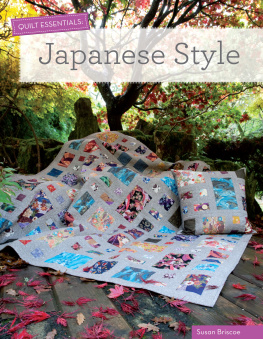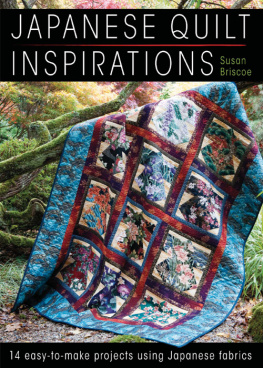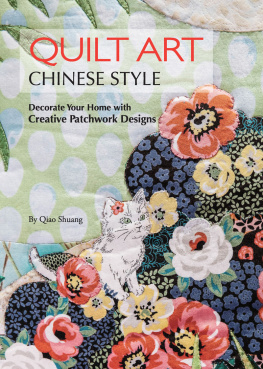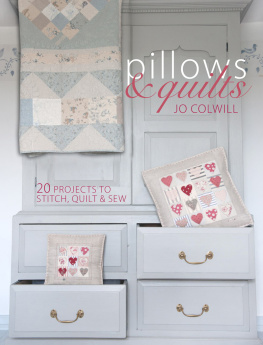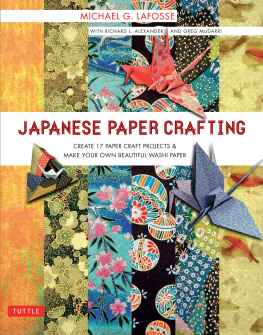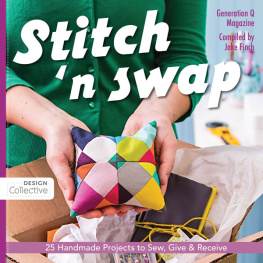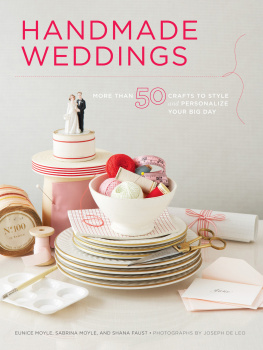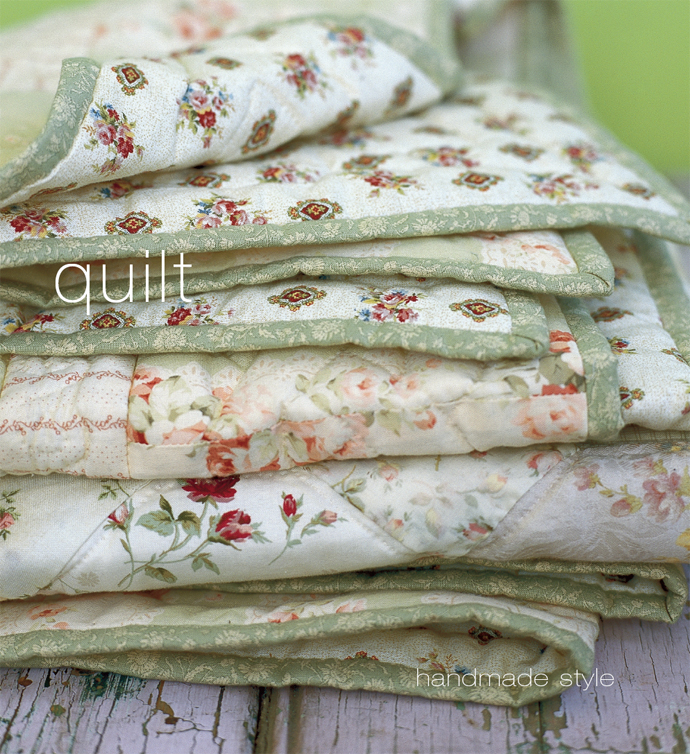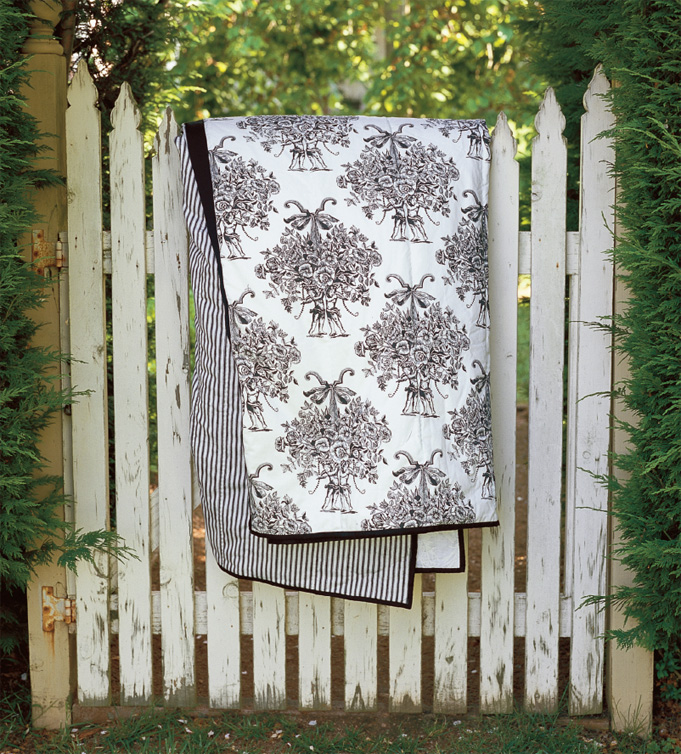Titles in the Handmade Style series
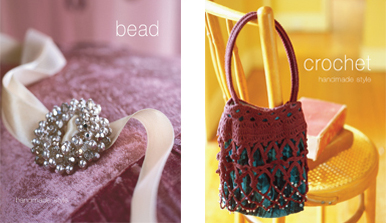
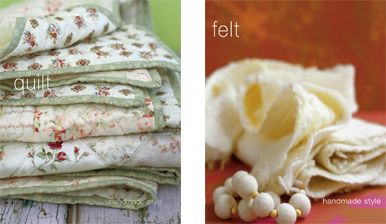
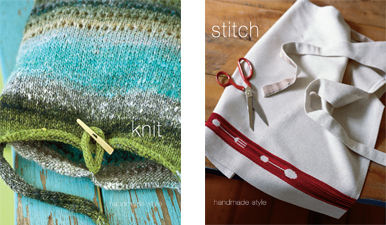
contents
techniques
projects
Introduction
Patchwork quilts have been around for centuries, well-loved and well-used household items that have been treasured by each generation then passed down to the next. There is perhaps nothing more evocative of home and family than a beautiful, handmade, cosy patchwork quilt. Once painstakingly pieced and quilted by hand, such quilts can now be made much more quickly and easily with sewing machines and quick techniques such as rotary cutting and chain piecing.
Quilting does not require any advanced sewing skills; most of the quilts in this book can be made by anyone with average sewing skills, and many are suitable for beginners. All of the quilts are designed to be machine-pieced, but they can be hand-pieced if you prefer. Similarly, many of them are hand-quilted, but they can be quilted by machine if you wish. Some people love the meditative nature of hand-sewing, and dont mind taking months or years to finish a quilt; others prefer the speed and ease of machine-sewing. Neither method is better than the other; they are simply different, so choose the method that suits your lifestyle and temperament and that you enjoy the most. If you find that you like piecing but not quilting, there are commercial quilting services available; these are often advertised in the back of quilting magazines.
The quilts in this book are a mixture of traditional and contemporary designs in both patchwork and whole-cloth quilts. If you like a particular design but are not keen on the fabrics in which it has been made, remember that the choice of fabric and colour can transform a traditional design into something modern looking, and vice versa. For example, the is pictured in romantic florals, but would look very striking and contemporary in zingy bright fabrics with black diamonds at the intersections of the squares.
If you are uncertain about the fabrics you intend to use for a particular quilt, buy a small amount at first and make a sample block to see if you like the effect. If not, try using the same fabrics, but arranging the components of the block in a different order. This can result in a very different effect. It is worth a little experimentation early on to avoid wasting time, money and effort on a finished quilt that doesnt meet your expectations.
The parts of a quilt
Most quilts consists of three layers: the quilt top (the decorative part); the batting (the filling that gives the quilt extra warmth and also contributes to its padded look); and the quilt backing. The batting may be omitted if you want a very light quilt for summer, or if the fabrics that you have used in the quilt top and backing are heavy enough on their own. The edges of the quilt are generally finished with binding.
The quilt top
Often, a quilt top will consist of a central design or a series of blocks surrounded by one or more borders. The top of the quilt may be pieced (made of patchwork), appliqud (with designs sewn onto a background) or whole-cloth (made entirely of one fabric). In whole-cloth quilts, the visual interest is created by the quilting alone, so these quilts are perfect for showing off a beautiful and intricate quilting pattern.
Batting
Also known as wadding, batting is the quilts filling, or middle layer. It may be made of wool, cotton or polyester; each has different properties (see left). Cotton and wool are easier to quilt than polyester, but polyester generally gives greater loft (thickness), although not usually greater warmth.
Backing
The quilt backing is usually made of one fabric, but there is nothing to stop you from making it wholly or partly from leftover patchwork blocks or strips of different fabrics. You will normally need to join two lengths of fabric to create a backing wide enough for anything larger than a cot or lap quilt.
Binding
This is a way of finishing the raw edges of all layers of the quilt by enclosing them in a thin strip of fabric. Binding is generally made from a double thickness of fabric for extra durability, as it is the edges of a quilt that will wear most quickly. Binding is usually the last thing to be done, once the quilting is finished.
Types of batting
Some battings need to be quilted closer together than others to stop them from drifting around within the quilt or fragmenting when washed. Polyester batting requires less quilting than cotton or wool batting. Some polyester battings have a tendency to fight the sewing machine. Wool battings (usually actually a wool/polyester blend) provide more warmth and comfort than polyester battings. However, they require more quilting, and those that are not needle-punched tend to pill. Needle-punched wool/polyester blends are more stable and require less quilting. Traditional cotton battings require a lot of quilting, as much as every 3 in (1375 mm). Needle-punched cotton battings are more stable and can be quilted up to 10 in (25 cm) apart.
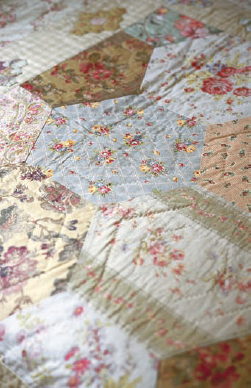
This is an alternative colourway of the design.
Fabric for quilts
For most quilts, it is best to use pure cotton fabrics. These wash and iron well, are easy to sew, take a crease well and do not fray excessively. Generally, all fabrics used for a quilt should be of a similar weight and weave. Using fabrics of different weights may result in some areas of the quilt wearing more quickly than others.
It is possible to use other fabrics, such as velvets, silks and satins, for a more luxurious effect. If using such fabrics, do not wash them before use. If they need ironing, do so at a low heat setting on the wrong side of the fabric. Quilts made from such fabrics should be dry cleaned, not washed.
Fabric can be solid (a uniform colour, without a print or pattern); printed; tone-on-tone (having a background printed with a design of the same colour); or checked. Printed fabrics are divided into four categories: small, medium, large and directional. Small prints may look almost like solid fabrics from a distance. Medium prints are more distinct and are often used to add visual texture. Large prints have very distinct patterns that stand out from the background. These are often used in quilts as borders or feature prints. Directional prints have a very distinct pattern that runs on one direction. Large directional prints, such as stripes, can be very effective when used in a border.
When choosing fabrics, give thought to both the balance of prints and plains as well as the tonal values of the fabrics; that is, the mixture of light, medium and dark fabrics. You will also find that the effect of a fabric may change according to the other fabrics surrounding it, with often surprising results. Experimenting with colour, tone and pattern is one of the pleasures of quilting.
Preparing fabrics
Many quilters prefer to wash, dry and iron cotton quilt fabrics before use. Wash each fabric separately in warm water with a scrap of white cotton fabric to test if the colour runs. If it does, the fabric should be discarded or used for another purpose. Otherwise, when the quilt is washed, the colour may run and ruin the quilt.


